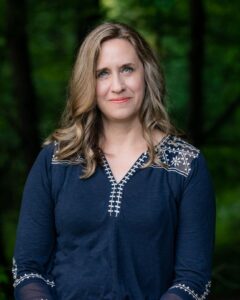 This month’s interview is with Marcy Campbell, whose debut picture book, Adrian Simcox Does NOT Have a Horse!, was a Junior Library Guild Selection, a Top 10 Indie Next Pick, Winner of the Comstock Read-Aloud Award, the recipient of the SCBWI Crystal Kite Award, and was translated into eight languages. She’s since gone on to write other award-wining picture books and middle-grade novels as well.
This month’s interview is with Marcy Campbell, whose debut picture book, Adrian Simcox Does NOT Have a Horse!, was a Junior Library Guild Selection, a Top 10 Indie Next Pick, Winner of the Comstock Read-Aloud Award, the recipient of the SCBWI Crystal Kite Award, and was translated into eight languages. She’s since gone on to write other award-wining picture books and middle-grade novels as well.
These days, she lives in Ohio with a husband, children, a rescue dog named Turtle, and two (formerly stray) cats. She’s also especially fond of:
- Soft pajamas
- A bed full of pillows
- Coffee
- Chocolate
Yeah, Marcy fits in great with the OPB family—no doubt about it. Let’s get to know our new friend even better via this interview!
RVC: In the bio on your website, you said you didn’t grow up with books. How did you come to love them enough to make it a career?
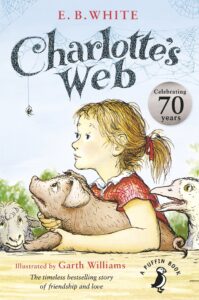 MC: I was always a storyteller. I made up stories to tell my pets at a very young age, but it was teachers who fueled my love of books. I still remember crying at my desk in fifth grade during a post-recess read aloud when Charlotte (from Charlotte’s Web) died. I still haven’t quite recovered.
MC: I was always a storyteller. I made up stories to tell my pets at a very young age, but it was teachers who fueled my love of books. I still remember crying at my desk in fifth grade during a post-recess read aloud when Charlotte (from Charlotte’s Web) died. I still haven’t quite recovered.
RVC: I fully understand. I haven’t quite recovered either.
MC: Because my family wasn’t into books, I started writing my own stories in elementary school and collecting them in a cardboard box I referred to as my “library.”
RVC: When did you first realize you were going to be a writer in terms of a career?
MC: There wasn’t an official parting of the clouds where a beam of light reached down, though that would have been cool. I’d always written, but I don’t remember really feeling like I’d earned the title “writer” until a beloved college professor (a successfully published author herself) sat me down one day in her office and told me I was. She gave me the pep talk I desperately needed, the “permission,” if you will, to feel proud of my work and confident enough to keep pursuing it, despite not having grown up with much support.
RVC: That’s awesome. Teachers like that are worth their weight in gold. Your first professional experiences as a writer were in public relations. What skills/lessons from that job translate well into the world of kidlit writing?
MC: More than anything, my job in PR gave me the opportunity to learn and practice many different types of writing for different audiences. I initially worked at an agency with various clients in different industries, and on any given day, I might be writing a newsletter, a speech, catalog copy, and oh so many press releases. When I decided to try writing for kids, I took the approach that since it was writing, I could study it, and figure it out.
RVC: What kind of formal training do you have in writing?
MC: My undergraduate degree is in Mass Communication/Public Relations, which involved a lot of writing courses, and I double-minored in English and Psychology (helpful when creating characters!). When I left the PR world, I went back to school to get an MA in Creative Writing. Though I learned a lot in my grad school courses, probably the most valuable part of that experience was being in a community of people who loved storytelling as much as I did and were committed to making it a career.
RVC: Please share the story of how you landed your literary agent, Steven Malk.
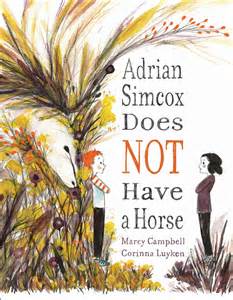 MC: Around the time I had a draft of Adrian Simcox Does NOT Have a Horse ready to go, I had a few friendly exchanges with a kidlit agent on Twitter, and she agreed to look, then kindly informed me I needed to cut the manuscript in half. She wasn’t interested in repping the book, regardless, so after making some major revisions, I started looking up agents on various lists I found online. That’s one way of doing it, and I sent a query to one agent from that research who never responded. But the better way to find an agent is to look at the books you love and see who represents those authors.
MC: Around the time I had a draft of Adrian Simcox Does NOT Have a Horse ready to go, I had a few friendly exchanges with a kidlit agent on Twitter, and she agreed to look, then kindly informed me I needed to cut the manuscript in half. She wasn’t interested in repping the book, regardless, so after making some major revisions, I started looking up agents on various lists I found online. That’s one way of doing it, and I sent a query to one agent from that research who never responded. But the better way to find an agent is to look at the books you love and see who represents those authors.
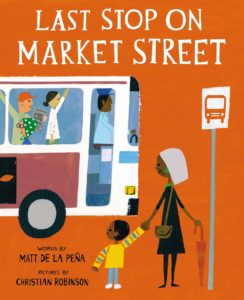 Last Stop on Market Street by Matt de la Peña and Christian Robinson had a huge impact on me as I was writing Adrian, and Steve Malk reps both Matt and Christian. So, I sent an email query with my manuscript to Steve, saying how much I loved that book. After a lengthy phone call, we started working together. I couldn’t believe it was happening for weeks afterwards, but if anyone thinks I was an “overnight” success, they should know I had racked up more than 300 agent and small press rejections on an adult novel I’d been working on for years. Turns out, I was just writing for the wrong age group.
Last Stop on Market Street by Matt de la Peña and Christian Robinson had a huge impact on me as I was writing Adrian, and Steve Malk reps both Matt and Christian. So, I sent an email query with my manuscript to Steve, saying how much I loved that book. After a lengthy phone call, we started working together. I couldn’t believe it was happening for weeks afterwards, but if anyone thinks I was an “overnight” success, they should know I had racked up more than 300 agent and small press rejections on an adult novel I’d been working on for years. Turns out, I was just writing for the wrong age group.
RVC: Thanks for sharing that–it’s helpful to put it all in perspective. Now, how long after you partnered up did you get the offer for your debut picture book, Adrian Simcox Does NOT Have a Horse?
MC: It happened quickly. Steve sent it out just after I signed with him, and we had multiple responses the same day. The book sold at auction shortly thereafter. I’ve since learned that super-speediness is not the norm!
RVC: I can confirm that! What’s the story of how that particular story came to you?
MC: When I decided I wanted to try writing a picture book, I started journaling ideas, and some of those ideas came from my own childhood. In early elementary school, I knew a boy who had a lot of nice things, and I was jealous of him. He also said he had a horse, which was not true, and it just drove me crazy because, although we lived on a farm, we did not have horses, and I really wanted one. The similarities to real-life end there, but that one line in my journal, “A boy says he has a horse, and a girl doesn’t believe him,” became my first published book.
RVC: What was the most important lesson that debut picture book taught you?
MC: Oh, so many! But one important thing was that you can’t please everybody. That book has done and is still doing extremely well–it’s won awards and all that–but of course, there are people who hate it. It’s easy to repeat the negative comments in your head and forget the positive ones, which are far more numerous. As a reader, I know not every book is for me. I’ve put aside award-winning novels that “everyone loves,” but if it’s not doing it for me, I stop reading and pick up something else, knowing I’m just not the right reader for that particular book at that particular time. Nothing against the author’s writing or my taste. I just move on. No books are universally loved.
RVC: Describe your writing process for picture books.
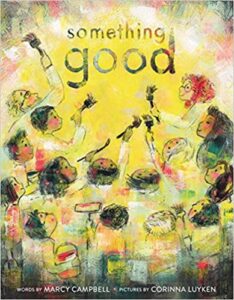 MC: Each one has been different. Something Good, for example, was my response to a real-life event, and came out pretty quickly. Others have taken more time to cultivate. I tend to freewrite around an idea for quite a while, picking it up periodically and adding more material until I start to see the shape of a story. At that point, I sit down to write a draft. Then, I put it away. Then, I pick it up in a few days or weeks and decide whether I still want to work on it.
MC: Each one has been different. Something Good, for example, was my response to a real-life event, and came out pretty quickly. Others have taken more time to cultivate. I tend to freewrite around an idea for quite a while, picking it up periodically and adding more material until I start to see the shape of a story. At that point, I sit down to write a draft. Then, I put it away. Then, I pick it up in a few days or weeks and decide whether I still want to work on it.
Sometimes, I think, well, that was a fun writing exercise, but it’s not a story, or at least not a story I’m interested in right now. When a story really grabs me, and I start working on individual lines, then it gets really fun. And, of course, I spend a lot of time reading my drafts aloud since that’s how picture books are mostly shared. It keeps my old dog awake when he’d rather be napping, but I think he forgives me.
RVC: How is the process different than for writing middle grade books?
MC: Very different. I tried being a “pantser” (flying by the seat of my pants) when I wrote my first novel, which never went anywhere. After reading a lot of craft books, and studying other middle-grade authors, I finally settled on a process that results in a loose outline, which I would describe more as a scene list rather than a formal, Roman numeral type of thing. To get to that point, though, I might have 100 pages of freewriting on plot, characters, etc., and once I get some things figured out, I work very physically, with scraps of paper for each scene, colored markers designating subplots, and a whole lot of floor to lay it all out. During the height of the pandemic, when my kids and husband were working from home, I ended up in our unfinished attic, in my winter coat, because it was the only place I could lay out all my scenes undisturbed. I’m sure I looked like I had completely lost my mind, but my family is used to that by now. And yes, I know there’s software for this type of thing, but I’m very tactile. I like to hold the scenes and move them around physically.
RVC: You just had another picture book come out. Is The More You Give a response to The Giving Tree?
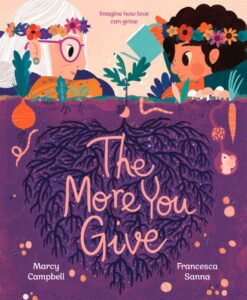 MC: Partially, yes. Believe it or not, I hadn’t read The Giving Tree until I became a parent and boy, did I hate it! So, I was thinking about writing a response to that with more giving, less taking, and no room for a rotten little boy/man. I also wanted a subtle message about caring for the environment. I also wanted to explain how some things that are worth doing can take a long time. I wasn’t sure whether I could do all of that in one book until I heard a proverb, “Plant a tree you’ll never see the shade of.” I was at an SCBWI conference when a speaker said that, and I have no idea what the rest of her talk was about because I started scribbling out a draft of The More You Give (at that time, called The Giving Boy) in the back of the room. Sometimes you just need that spark to tie all your ideas together.
MC: Partially, yes. Believe it or not, I hadn’t read The Giving Tree until I became a parent and boy, did I hate it! So, I was thinking about writing a response to that with more giving, less taking, and no room for a rotten little boy/man. I also wanted a subtle message about caring for the environment. I also wanted to explain how some things that are worth doing can take a long time. I wasn’t sure whether I could do all of that in one book until I heard a proverb, “Plant a tree you’ll never see the shade of.” I was at an SCBWI conference when a speaker said that, and I have no idea what the rest of her talk was about because I started scribbling out a draft of The More You Give (at that time, called The Giving Boy) in the back of the room. Sometimes you just need that spark to tie all your ideas together.
RVC: What are you most pleased with regarding that book?
MC: Francesca Sanna’s art is just breathtakingly lovely. I love poring over all the little details. I especially like flipping between the spreads where the forest is growing bit by bit. And the last spread, with a celebration taking place in the woods, is one of those images I wish I could drop myself right into in real life.
RVC: What’s the best writing advice you ever received? Who gave it, and what did it mean to you?
MC: When I had that life-changing discussion with the professor I mentioned before, I remember her passing along some advice that she herself had gotten as a young author from her great-aunt, who told her, “Somebody’s got to write all those books. Why shouldn’t it be you?” It’s incredibly simple, but at the time, since I was crippled with major imposter syndrome, it really made a difference. There’s tons of writing advice I’ve been given and ignored, too. Write what you know, write every day, quit watching cat videos …
RVC: In all your experience of being a writer, what has most surprised you?
MC: I think when I started, I was worried I wouldn’t be able to come up with ideas, which has not been a problem. Ideas really are everywhere. It’s coming up with viable ideas, ones that will translate well unto the page and be compelling to read, that is more difficult. On the business side, I had no idea how long it takes to produce a book, especially a picture book. There are so many steps involved, and so many people. I’m amazed that a picture book doesn’t cost a hundred dollars.
RVC: One final question for this part of the interview, please. What new projects are you working on?
MC: I have a picture book titled, What Are You Waiting For? in the works, with Shelley Johannes illustrating (Little, Brown, 2025). It’s a book about taking chances and pursuing goals, and picking yourself up when things don’t go as planned. I’m also working on another middle-grade novel and, of course, always thinking up picture book ideas.
RVC: Alrighty. Now it’s time for the Speed Round, which means blazing-fast questions followed by meteor-swift answers. Are you ready?
MC: SO ready.
RVC: What secret talent do you have that no one would suspect?
MC: Cattle judging? Though I never did particularly well in those competitions (it’s all about the udder, folks). I was, however, the junior dairy showmanship winner at our county fair. This is basically the ability to lead a calf around with a halter in a very controlled and, can I say graceful? manner. I have a way with animals, large and small, and have always adored them. I also don’t eat them. I’m a whiz at organizing things, too, though people who know me wouldn’t be surprised by that. I can take your junk drawer and turn it into a thing of beauty.
RVC: What animal would be cutest if it were scaled down to the size of a kitten?
MC: Buffaloes. Watch out for the tiny horns, though.
RVC: If someone narrated your life, who would you want to be the narrator?
MC: Is Morgan Freeman available? He could bring some gravitas to my daily tasks for sure. “And now the author takes a break from writing a sure-to-be bestseller … to clean the toilets.”
Can you hear it?
RVC: What surprising books are on your nightstand?
MC: I always have home decorating books and magazines around. If it’s a night where I don’t want to get too involved in a book (and stay up too late), I read those. I’ve had a copy of Dracula there for over a year. My daughter read it in her language arts class, and since I’ve never read it, I borrowed it from her. Every time I dip into it, though, I get too scared and end up having weird dreams. Someday I will finish it…in the daytime.
RVC: Who sets the standard for emotional picture books?
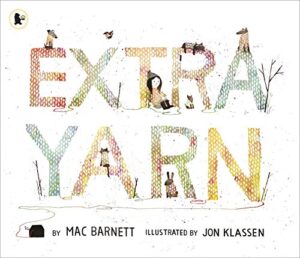 MR: Big influences for me have been Jacqueline Woodson, Matt de la Peña, Philip Stead, Mac Barnett (I’m thinking of Extra Yarn here, though Mac is a great inspiration for funny books, too).
MR: Big influences for me have been Jacqueline Woodson, Matt de la Peña, Philip Stead, Mac Barnett (I’m thinking of Extra Yarn here, though Mac is a great inspiration for funny books, too).
On the middle-grade side, Kate DiCamillo has been my guiding star.
RVC: What’s the best compliment a child ever gave your books?
MC: A very shy little girl came to one of my events recently with her mom. She didn’t speak to me, but gave me a book she had made with folded paper and crayons. It was a story about her, and me, and books. I was so incredibly touched. That a child could imagine herself so fully in conversation with me through my books, that she would create her own book about it, well, that was something awfully special. I keep the book in my office where I can see it, in case I need a reminder of who I’m writing for.
RVC: What a way to end this interview. Thanks so much, Marcy!


This was a lovely interview.
Please write many, many more books!
Oh my goodness! What a wonderful and inspiring interview! Thank you!
What an insightful interview. Thanks.
Wonderful interview! Marcy’s favorite authors are some of mine, too!
She’s got good taste–no doubt about it!
Thanks for stopping by OPB, Andrea. Come back anytime.